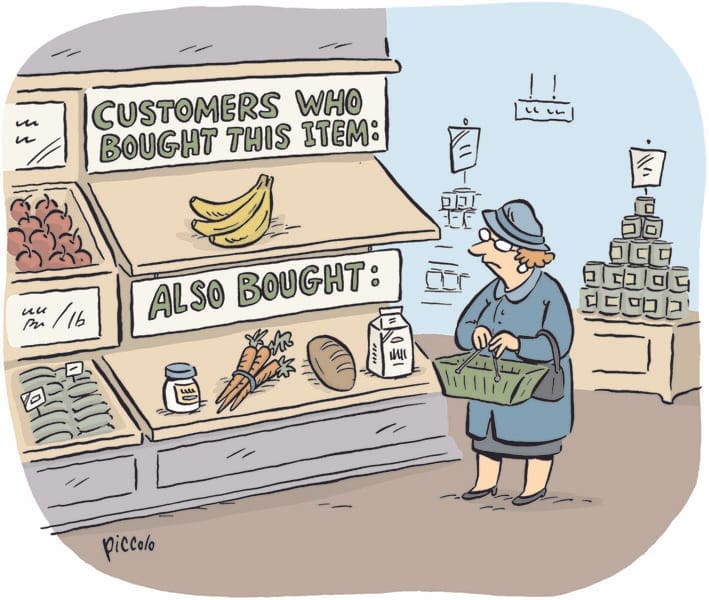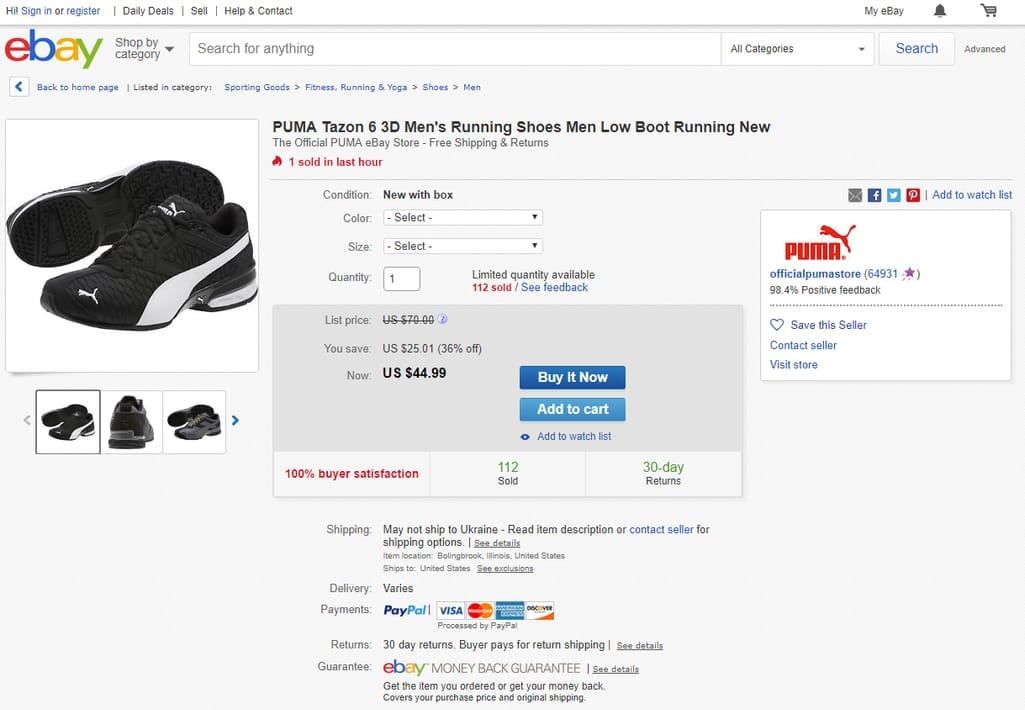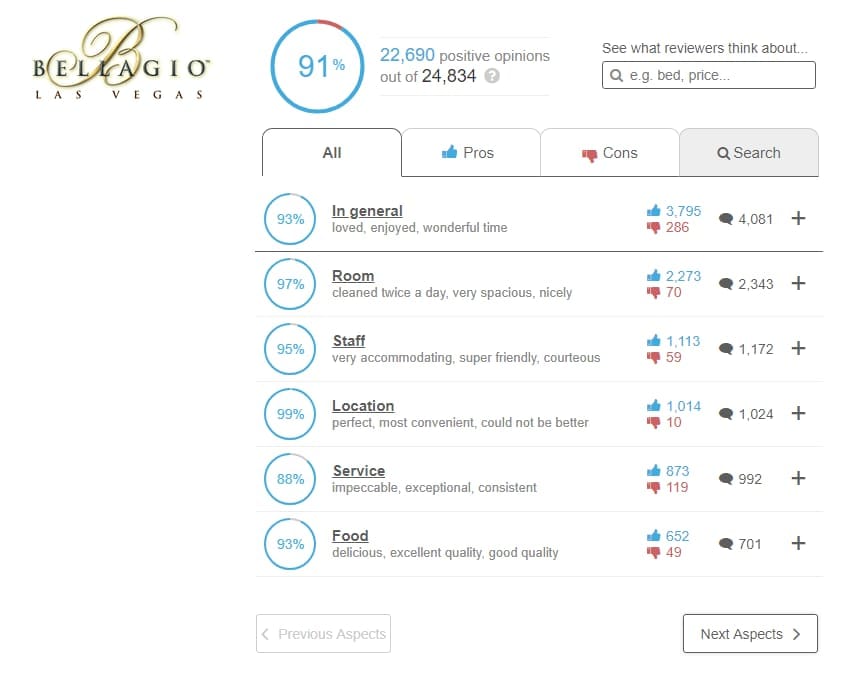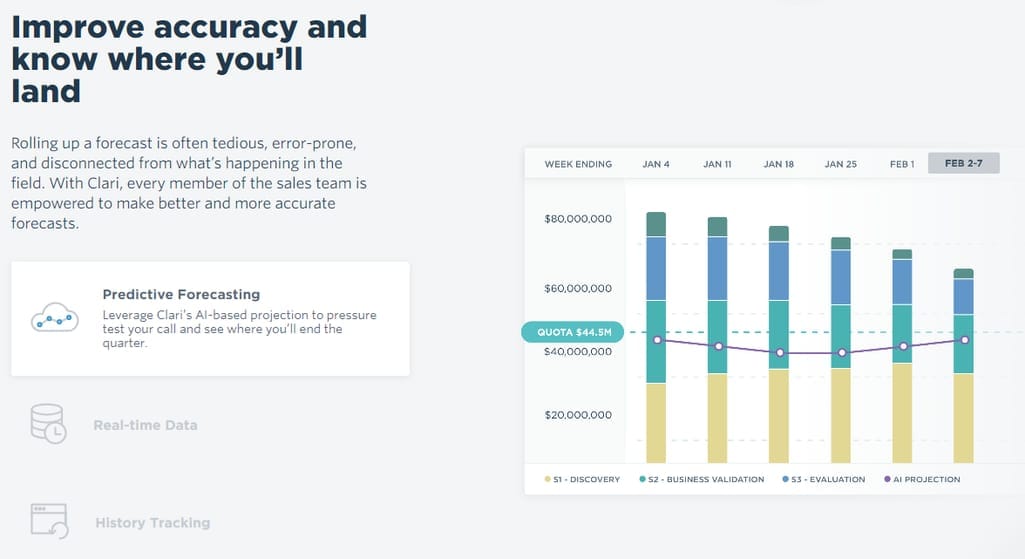Amazon is every online retailer’s forbidding nightmare. Last year, it dominated 44 percent of the US eCommerce market and about 4 percent of all domestic retail sales. One Click Retail, an eCommerce analysis provider, explains its dominance with the fact that millennials, Amazon’s core demographic, are getting older and starting to spend more. Moreover, advanced marketing capabilities for sellers, developments in Alexa, and pioneering in applications of the hottest technologies make it impossibly hard for smaller competitors to actually… well, compete.
Amazon is not only a simple and familiar platform selling everything you can think of – it’s also one of the most innovative players on the market. It shapes the picture of today’s online shopping experience and creates a new standard for what shopping in the world is like.
Comic by cartoonist Rina Piccolo
To understand their customers better and satisfy these expectations, many eCommerce brands today use artificial intelligence. The technology’s most popular subset – machine learning – can make sense of all data that online shops collect, drive insights that improve customer experience, boost internal business processes, and fight fraud. Today we will describe these opportunities – each of which you can start implementing in your business right now.
1. Personalized shopping experience
Personalization is real-time customization of a customer’s journey. Likely as not, your platform already collects and stores a ton of information about your users. Google Analytics alone provides you information about user location, their device, browser, and the operating system they use, not to mention how much time they spend on each page and where they came from.
Called metadata, this technical information’s easily available and reliable, though not always very useful. Additionally, you probably store other types of data, such as behavior data about users’ clicks and actions or information from your CRM. We’ve thoroughly discussed how to approach personalization in our travel-focused piece and described our first-hand experience in creating personalized platforms.
Have you noticed how much content Amazon, or Alibaba, or eBay provide? They are not exactly minimalist sites. 
eBay doesn’t really follow the minimalistic UX trend
Often, the more there is for a user to interact with, the greater the accuracy of the personalized experience. Machine learning is able to use the smallest piece of data about every hover or followed link to personalize on a deeper level. It almost feels like the system can read a user’s mind.
In practice this personalization results in timely messages, alerts, visuals that should be specifically interesting to each person, and dynamic content that changes according to demand and supply. 
A mobile-first store Wish.com has skyrocketed into eCommerce Olympus with personalized suggestions and tailored discounts
By learning to understand and use the data users are leaving behind, stores can automatically change interface language and currency, offer time limits on potentially desirable items, and send notifications about discounts on the most purchased items.
2. Fighting fake reviews
Customer reviews have played and still play an important role in helping people make purchasing decisions. Ninety-seven percent of people read online reviews regularly and 87 percent trust them just as much as personal connections. However, people are getting more skeptical. Last year’s controversies around fake content have impacted the way customers perceive information they find online, even if it’s seemingly written by peers. The battle for truth in media has never been as fierce as it is today.
These days artificial intelligence is capable of analyzing large volumes of user-generated content. Let’s take an example from research firm Aspectiva. They used machine learning algorithms to analyze reviews for Bellagio, the Las Vegas hotel, across the whole web and gathered about 25,000 opinions. The overwhelming numbers allow customers to see the truth since there are always more real than fake reviews. This engine can be used by online shops to leverage the public opinion that was already expressed on the web instead of inviting fake reviews on their platform. 
Bellagio reviews collected by Aspectiva
Another way to battle malicious reviews is used by Amazon. In 2015 they changed their rating system that used to simply calculate an average of all reviews. This allowed a single negative review to influence the whole rating of a product and vice versa. Now, their self-improving, machine learning-based system picks one review it thinks to be true according to different factors such as upvotes, recency, and whether it was written by a verified user. Then, it brings these reliable reviews to the top.
Delve into our comprehensive whitepaper to learn how else machine learning detects fraud in eCommerce.
3. Inventory management and sales forecasting
Sales forecasting is one of the biggest disruption opportunities in commerce. Being able to tell how much of a given product you will sell by a certain date allows shops to stock inventories more efficiently and eliminate large sums of unwanted costs. It’s especially valuable working with perishable products, which include not only groceries, but also concert and transportation tickets – anything that makes you lose money when it’s unsold.
Today, AI-powered software can gather historical data about past purchases and help sales departments drive conclusions for easier decision-making. Such conclusions include:
- Identifying the most and least popular products during an exact period of time
- Suggesting products that can be successfully promoted on a given date
- Predicting how upcoming sports and cultural events impact sales
- Calculating probability of a purchase to give short-term views on turnover

Clari leverages machine learning to analyze real-time data and drive predictions
Sales predictions also have a vast influence on inventory management. Being aware of slumps and spikes in demand helps prevent the ordering of out-of-stock goods or piling up inventory of stock that will not be sold. To reduce product loss or spoilage, minimize waiting costs and storage, companies analyze customer behavior via machine learning. There’s an interesting instance involving Walmart’s use of Watson’s weather analytics to learn that people crave steak more when it’s warm but windy outside and salad – if the temperature is above 80 degrees.
4. Automated customer service and chatbots
Today, you won’t find a big online store that doesn’t offer some form of customer support channel. However, it costs businesses $1.3 trillion every year to answer customer calls. This includes keeping support agents busy 24/7 and wasting human resources that can be otherwise directed towards more creative and intelligent tasks. Here’s when chatbots come into the picture.
AI-enabled personal assistants are capable of answering simple questions. They can give a customer the status of an order and perform mundane tasks like finding a specific item just by a customer’s description. eBay joined the chatbot game years ago when it introduced a simple Messenger bot to send reminders to bidders. Now it has ShopBot – a more advanced version that will find you a Father’s Day gift within your budget and even locate a listing by an uploaded picture. Similar bots are available from Sephora, H&M, Burberry, and Pizza Hut. 
ShopBot on Facebook Messenger

Chatbot by Mode.ai combines AI-powered search with prompt cards
Chatbots elevate the online shopping experience by:
- Reducing response time and giving instant answers in comparison to human assistants
- Increasing user retention by sending notifications and reminders
- Providing upselling opportunities through the personalized approach
5. AI-powered Customer Relationship Management (CRM) systems
Sales automation has become a trend in 2017. The amount of data businesses can gather from customers and the number of channels through which we can interact with them have grown exponentially during recent years and our marketing and sales programs need to reflect that. Today, with many businesses still running their marketing activities in Excel spreadsheets, the CRM systems market is ready to adopt changes. The main challenges businesses are faced with right now are:
- Manual data input and the risk of errors
- Viewing historical reports instead of tracking KPIs
- Lack of connectivity between CRM data and data from other company systems
Today major CRM vendors including Salesforce, SAP, Oracle, Microsoft, and Adobe have all invested in AI-powered startups to introduce AI capabilities in their systems. Salesforce, for instance, offers Einstein – a tool aimed at making AI applications more accessible for all businesses. The tool can prioritize leads most likely to convert, automatically add data to a CRM, provide personalized recommendations to shoppers, and even analyze what your customers are sharing about you on social media. 
Using Einstein in Salesforce’s CRM
6. Visual search
One of the biggest openings for AI technology in eCommerce is helping clients find products faster. It can be achieved using chatbots or making textual search more semantic, but one of the most promising technologies is visual search through image recognition. The technology benefits all: Customers instantly find exactly what they want allowing businesses to majorly shorten the user journey culminating in checkout. Pinterest’s Lens tool is one of the brightest examples of visual search. The brand partnered with fashion companies to find the matching items in store directly from the image found on Pinterest. Fashion giant ASOS launched a similar tool allowing customers to find items on the site like the ones on their Camera Roll. 
Visual search on ASOS
According to L2’s research, only 8 percent of specialty retail brands are using visual search today. However, it’s clearly the feature users enjoy: Year-over-year, the use of the technology has grown by 70 percent.
7. Voice search and smart homes integration
Connected home applications are the biggest part of all consumer IoT markets today and it inevitably changes the way people make purchases. Just last year, a six-year-old accidentally ordered a dollhouse when asking Amazon Alexa to play with her. This new ability to ask an assistant to order products makes it easier for eCommerce brands to reach customers.
According to this year’s study – one in six Americans owns a smart speaker. That’s 128 percent more than in early 2017. The capabilities for reaching people through Alexas and Google Homes grew too: Now everyone can build an Alexa skill for their virtual shop with Amazon’s kit of self-service APIs. Thus, retail brand Woot allows Alexa users to ask about the daily deal, Bed Bath and Beyond to dispense life hacks, and Lamps Plus to inform about order status.
The basic list of features you might want to provide in your voice assistant includes:
- Adding/removing an item from cart
- Checking cart
- Check out with cart items
- Reorder previous order
- Review shipping status
- Check availability
8. Combating counterfeit products
Amazon, along with many other big retail brands, has a counterfeit problem. The number of counterfeit items sold via Amazon’s marketplace prompted Apple to file a lawsuit against vendors selling fake products, and even convinced brands like Swatch and Birkenstock to leave the service altogether. Amazon fights the problem by marking legitimate brands in their Brand Registry. However, low prices still attract customers to buy from unauthorized sources.
Several opportunities have arisen that use deep learning and image recognition technologies to detect fake products. Thus, DataWeave tackles the problem of image theft by training neural networks on millions of catalogue items from different categories. Alibaba, trying to fight its reputation as a platform for cheap fakes, introduced a bot scanning system that analyzes each product added to their listings every day. The tool also reviews user behavior data, payments, and logistics to detect suspected goods and merchants.
Understanding customers better - the key to eCommerce success
Researches from Nielsen Norman Group, a leading user experience research lab, have recently described what modern online shoppers expect from eCommerce websites. Here are six major themes they noticed in customer expectations:
- Convenience. This characteristic includes personalized recommendations, detailed item descriptions, easy reordering, and voice-activated assistants.
- Speed. Immediacy not only implies fast delivery, but also one-click purchases and streamlined checkout processes.
- Assurance. Customer standards for privacy and security have heightened resulting in the expectation of feeling safe and protected.
- Accuracy. Geolocation, user reviews, and correct arrival dates all help elevate trust and make people more forgiving about mishaps.
- Options. Customers want to be flexible with payment options, chosen devices, and channels to connect with vendors.
- Experience. Customers value elements of surprise and uses of uncommon technologies such as visual search.
It’s easy to notice how the opportunities we described earlier can shape the customer experience people are searching for. Tell us what you think will be the biggest driver of AI development in online shopping. What applications do you think will dominate the current eCommerce scene? We’re looking forward to hearing about your insights.

